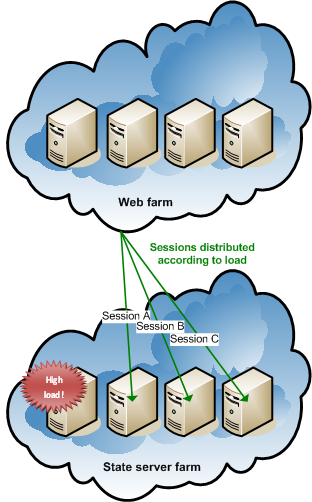ASP.NET Session State Partitioning using State Server Load Balancing
Edit on GitHub It seems like amount of posts on ASP.NET's Session State keeps growing. Here's the list:
It seems like amount of posts on ASP.NET's Session State keeps growing. Here's the list:
Yesterday's post on Session State Partitioning used a round-robin method for partitioning session state over different state server machines. The solution I presented actually works, but can still lead to performance bottlenecks.
Let's say you have a web farm running multiple applications, all using the same pool of state server machines. When having multiple sessions in each application, the situation where one state server handles much more sessions than another state server could occur. For that reason, ASP.NET supports real load balancing of all session state servers.
Download example
Want an instant example? Download it here: SessionPartitioning2.zip (4.16 kb)
Want to know what's behind all this? Please, continue reading.
What we want to achieve...
Here's a scenario: We have different applications running on a web farm. These applications all share the same pool of session state servers. Whenever a session is started, we want to store it on the least-busy state server.
1. Performance counters
To fetch information on the current amount of sessions a state server is storing, we'll use the performance counters ASP.NET state server provides. Here's a code snippet:
[code:c#]
if (PerformanceCounterCategory.CounterExists("State Server Sessions Active", "ASP.NET", "STATESERVER1")) {
PerformanceCounter pc = new PerformanceCounter("ASP.NET", "State Server Sessions Active", "", "STATESERVER1");
float currentLoad = pc.NextValue();
}
[/code]
2. Creating a custom session id
Somehow, ASP.NET will have to know on which server a specific session is stored. To do this, let's say we make the first character of the session id the state server id from the following IList:
[code:c#]
IList<StateServer> stateServers = new List<StateServer>();
// Id 0, example session id would be 0ywbtzez3eqxut45ukyzq3qp
stateServers.Add(new StateServer("tcpip=10.0.0.1:42424", "sessionserver1"));
// Id 1, example session id would be 1ywbtzez3eqxut45ukyzq3qp
stateServers.Add(new StateServer("tcpip=10.0.0.2:42424", "sessionserver2"));
[/code]
Next thing we'll have to do is storing these list id's in the session id. For that, we will implement a custom System.Web.SessionState.SessionIDManager class. This class simply creates a regular session id, locates the least-busy state server instance and assign the session to that machine:
[code:c#]
using System;
using System.Diagnostics;
public class SessionIdManager : System.Web.SessionState.SessionIDManager
{
public override string CreateSessionID(System.Web.HttpContext context)
{
// Generate a "regular" session id
string sessionId = base.CreateSessionID(context);
// Find the least busy state server
StateServer leastBusyServer = null;
float leastBusyValue = 0;
foreach (StateServer stateServer in StateServers.List)
{
// Fetch first state server
if (leastBusyServer == null) leastBusyServer = stateServer;
// Fetch server's performance counter
if (PerformanceCounterCategory.CounterExists("State Server Sessions Active", "ASP.NET", stateServer.ServerName))
{
PerformanceCounter pc = new PerformanceCounter("ASP.NET", "State Server Sessions Active", "", stateServer.ServerName);
if (pc.NextValue() < leastBusyValue || leastBusyValue == 0)
{
leastBusyServer = stateServer;
leastBusyValue = pc.NextValue();
}
}
}
// Modify session id to contain the server's id
// We will change the first character in the string to be the server's id in the
// state server list. Notice that this is only for demonstration purposes! (not secure!)
sessionId = StateServers.List.IndexOf(leastBusyServer).ToString() + sessionId.Substring(1);
// Return
return sessionId;
}
}
[/code]
The class we created will have to be registered in web.config. Here's how:
[code:c#]
<configuration>
<system.web>
<!-- ... -->
<sessionState mode="StateServer"
partitionResolverType="PartitionResolver"
sessionIDManagerType="SessionIdManager" />
<!-- ... -->
</system.web>
</configuration>
[/code]
You notice our custom SessionIdManager class is now registered to be the sessionIDManager. The PartitionResolver I blogged about is also present in a modified version.
3. Using the correct state server for a specific session id
In the previous code listing, we assigned a session to a specific server. Now for ASP.NET to read session state from the correct server, we still have to use the PartitionResolver class:
[code:c#]
using System;
public class PartitionResolver : System.Web.IPartitionResolver
{
#region IPartitionResolver Members
public void Initialize()
{
// No need for this!
}
public string ResolvePartition(object key)
{
// Accept incoming session identifier
// which looks similar like "2ywbtzez3eqxut45ukyzq3qp"
string sessionId = key as string;
// Since we defined the first character in sessionId to contain the
// state server's list id, strip it off!
int stateServerId = int.Parse(sessionId.Substring(0, 1));
// Return the server's connection string
return StateServers.List[stateServerId].ConnectionString;
}
#endregion
}
[/code]
This is an imported post. It was imported from my old blog using an automated tool and may contain formatting errors and/or broken images.


20 responses